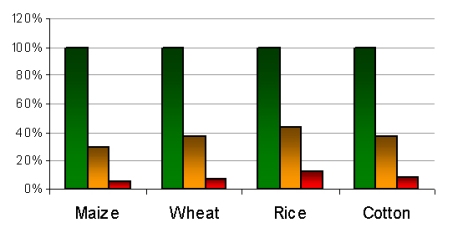This week we start off with a United Nations report that urges caution on biofuels. Green Inc, a New York Times blog writes,
“The study concluded that whether a biofuel is climate-friendly or not depends largely on whether it is based on crops or production residues. Biofuels of the latter category were generally considered beneficial for the environment, and generating electricity locally from waste materials was found — in most cases — to be more energy efficient than converting biomass to liquid fuels.”
This paper was also written about in the blog, Futurism Now, the post called, Biofuels Will Increase Global Warming According to Study
They explain,
“That is because the land required to plant fast-growing poplar trees and tropical grasses would displace food crops, and so drive deforestation to create more farmland, a powerful source of carbon emissions.”
Not so fast, check out the Sustainable Production of Biofuels.
And biofuels continues to be the topic of the week. The biofuel review writes this week about a report from the Imperial College of London. The report has an upbeat tone about the future of biofuels and The biofuel review ends their post with a quote from Clare Wenner, Head of Renewable Transport at the Renewable Energy Association that says,
“Imperial College London has verified the results which show that these fuels can be produced in a sustainable way. With the right legislative framework, including the implementation of environmental rules under the Directive, it will be possible to limit indirect land use effects. Land will always be used for food and fuel, and the overall balance of these impacts could be positive as far as food is concerned. In fact, it seems likely that wheat-based biofuels production will not affect the amount of wheat exported by the EU as a whole.”
Then it’s more biofuels from Creamer Media’s Engineering News
According to Engineering News,
“Pretreatment and gasification technologies are on the verge of making second-generation biofuels a commercial reality, according to new analysis from Frost & Sullivan, entitled ‘Worldwide Market Analysis of Second Generation Biofeedstock.”
Engineering news interviewed Frost & Sullivan senior research analyst Phani Raj Kumar Chinthapalli,
“The use of second-generation biofuels is expected to reduce the emission of greenhouse gases (GHG), particularly carbon dioxide (CO2), from combustion engines by 80% to 85% in comparison with conventional fossil fuels. The lifecycle emissions for second-generation biofuels are in the negative range, which implies consumption of CO2 rather than emission.”
That’s it for this week, see you next week.
Filed under: biofuel, Biofuel Technology, Climate Change | Tagged: biofuel, biofuels, biotechnology, cellulosic, Climate Change, environment, environmental protection agency, ethanol, Food and Fuel, food crisis, food vs. fuel, greenhouse gas, greenhouse gas emissions, indirect land use change, sustainability, sustainable energy | Leave a comment »




